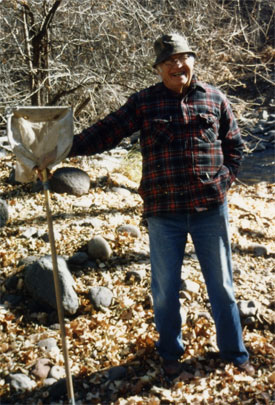Milton W. Sanderson

Dr. Milt Sanderson is widely renown as a specialist on the genus Phyllophaga (Melolonthinae), and he conducted most of his work at the Illinois Natural History Survey. He first encountered scarabs as a child, when he caught Cotinis nitida in Oklahoma, tied string to their legs, and flew them as kites. He began his studies in 1928 when he entered the University of Kansas. He was interested in Phyllophaga and water beetles from the start and began collecting and publishing papers about them. NABs members are most likely to know of Milt through his work on dryopoid and elmid water beetles.
His first full time job was at the University of Arkansas, where he worked on white grubs (Phyllophaga spp. and Cyclocephala spp.). From there, he spent many years at the Illinois Natural History Survey, but, being a state agency, much of his work was "directed", meaning that he could not devote as much time to Phyllophaga as he would have wished. He has been retired since 1975, but he conducted his own post-retirement studies of aquatic Hemiptera and wild flowers.
Selected publications
- Sanderson, M.W. 1937. Three new species of Phyllophaga (Coleoptera: Scarabaeidae) with notes on two species new to Kansas. Journal Kansas Entomological Society 10: 14-19.
- Sanderson, M.W. 1938. A monographic revision of the North American species of Stenelmis (Dryopidae: Coleoptera). University Kansas Science Bulletin 25: 635-717.
- Sanderson, M.W. 1939. A new genus of Scarabaenidae with descriptions and notes on Phyllophaga. Journal Kansas Entomological Society 12: 1-15.
- Sanderson, M.W. 1948. Larval, pupal and adult stages of North American Physonota (Chrysomelidae). Annals of the Entomological Society of America 41: 468-477
- Sanderson, M.W. and E. W. King. 1951. Some generic synonymy in North American tortoise beetles with descriptions of two new species. Journal Kansas Entomological Society 24: 125-128.
- Sanderson, M.W. 1953. New species and a new genus of New World Elimidae with Supplemental keys. The Coleopterists' Bulletin 7: 33-40.
- Sanderson, M.W. 1953-54. A revision of the Nearctic genera of Elmidae (Coleoptera). Journal Kansas Entomological Society 26: 148-163 and 27: 1-13
- Sanderson, M.W. and H. P. Brown. 1956. Records of Oklahoma riffle beetles and a description of the larvae of Hexacylloepus (Coleoptera: Dryopoidae). Proceedings of the Oklahoma Academy of Science 37: 67-72.
- Sanderson, M.W. 1958. Faunal Affinities of Arizona Phyllophaga, with Notes and Descriptions of New Species (Coleoptera, Scarabaeidae). Journal Kansas Entomological Society 31: 158-173.
- Leech, H. B. and M. W. Sanderson. 1959. Coleoptera. pp. 981-1023 in W. T. Edmondson (editor), Freshwater Biology, 2nd edition, Wiley, New York.
- Brigham, W. U. and M. W. Sanderson. 1972. A new species of Haliplus from Illinois and South Dakota (Coleoptera: Haliplidae). Transactions of the Illinois State Academy of Science 65:17–22 .
- Brigham, W. U. and M. W. Sanderson. 1973. Haliplus variomaculatus, a new species from east-central Illinois (Coleoptera: Haliplidae). The Coleopterists' Bulletin 27: 157-163.
- M. W. Sanderson. 1982. Aquatic and Semiaquatic Hemiptera. In: A. R. Brigham, W. U. Brigham and A. Gnilka (eds.). Aquatic insects and oligochaetes of North and South Carolina. Midwest Aquatic Enterprises, Mahomet, Illinois.
- Blinn, D. W., C. Pinney, M. W. Sanderson. 1982. Nocturnal planktonic behavior of Ranatra montezeuma Polhemus (Nepidae: Hemiptera). Journal Kansas Entomological Society 55: 481-484.
- Blinn, D. W.; Sanderson, M. W. 1989. Aquatic insects in Montezuma Well, Arizona, USA a travertine spring mound with high alkalinity dissolved carbon dioxide. Great Basin Nat. 49(1): 85-88.
- Polhemus, J. T.; Sanderson, M. W. 1987. Drake in Arizona, a species new to the USA (Heteroptera: Veliidae). Great Basin Naturalist 47(4): 660.
- Usher, H. D.; Blinn, D. W.; Sanderson, M. W. 1986. A key to the aquatic insects of streams in the vicinity of the Rocky Mountain Biological Lab, including chironomid larvae from streams and ponds.

